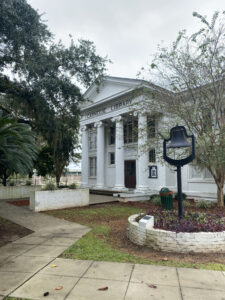
Florida A&M’s campus is home to a number of buildings and statues, as well as great scenery. Tucked in a corner right off to the side of the quad sits the Meek-Eaton Black Archives.
On the webpage for The Black Archives, it states that the museum “came to existence in 1971, when the Florida Legislature mandated the creation of a repository to serve the state by collecting and preserving source material on about African Americans from ancient to present times.”
The center was officially founded in 1976 by one of FAMU’s history professors, James N. Eaton. The archives is located in Carnegie library.
Carnegie Library was built after Andrew Carnegie donated $10,000 to the Florida State College for Colored Students (present-day FAMU).
There is a plethora of information, history and artifacts located in the archives, but why aren’t students taking advantage of it?
Graduating senior Sebastianie Pompee said that she has never been to the Black Archives.
When asked why she hasn’t visited the museum, Pompee said, she doesn’t know where it is. This is understandable since though the archives is only partially visible behind trees and bushes.
If a student didn’t already know it was there, then they wouldn’t even realize they were walking past it.
The Black Archives is located right across from Tucker Hall. Approaching it coming off the quad, it looks like a small white building that doesn’t seem to be in use.
Pompee, who will be graduating this semester with a degree in psychology, said, “I only go to campus for class or for practice, then I go home.”
Some students, like Pompee, are only on campus for one thing, class.
With the hope of bringing more traffic to the archives, The History of FAMU lecture series was created.
This is a virtual event, hosted by Professor Reginald Ellis, Each series has a different topic and will feature lectures and discussions from scholars, alumni, students and other members of the FAMU community.
Newly appointed interim director of the Black Archives, Darius Young, is an associate history professor at FAMU. Young is also the director of the FAMU Quality Enhancement Plan.
The idea of the lecture series came from Young himself.
“I thought about creating the FAMU lecture series after the passing of our former president Dr. Frederick S. Humphries this summer,” Young said. “I think it is important for us to remember the individuals who helped pave the way for FAMU to be considered among the elite HBCUs in the country.”
The series was started this semester and the first lecture, which was held on Sept. 23, was a successful event.
“There are countless stories that still need to be told regarding FAMU’s history,” Young said. “I am hoping that we can at least continue the series for the remainder of this academic year.”
Young is a FAMU graduate who believes that “the archives played an important role in his development as a researcher and a scholar.”
“The FAMU Department of History and African American Studies has produced around 40 Ph.D. students over the past two decades, and the Meek-Eaton Black Archives is central to our success as a department,” Young said.
In a previous article, Young said that he is “eager to return to the archives and help advance [the archives] central priorities.”
When asked about how he plans to do this, Young said that he intends to “heighten MEBA’s visibility in the academy by providing more programming, publications, research fellowships for students and faculty and internships.”
He plans on doing this “through our new partnership with the Smithsonian’s National Museum on African American History and Culture. We are looking to work more in the digital humanities space and develop digital exhibits of our collections.”
Although Young is interim director he is most excited about “the opportunity to increase MEBA’s presence as an important academic center for students, scholars, and the community. It has the potential to make a more significant contribution to the academic, research, and service mission of FAMU.”
The archives is a great place for students to learn about FAMU’s history as well as many other things. The museum has about 14 exhibits students, alumni and the public can explore.